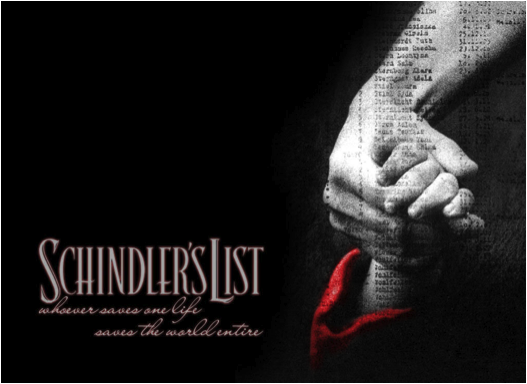As part of our “Lessons in Leadership–Hollywood Style” project, our group examined the leadership styles and ethical dilemmas found in the powerful 1993 film Schindler’s List.
 “Whoever saves one life saves the world entire.”
“Whoever saves one life saves the world entire.”
THE FACTS
- Director: Steven Spielberg
- Writers: Thomas Keneally (who wrote the orginial book), Steven Zillian (screenplay)
- Stars: Liam Neeson (Oskar Schindler), Ralph Finnes (Itzhak Stern), Ben Kingsley (Amon Goeth)
- Summary: Based on a true story, Schindler’s List follows the transformation of Oskar Schindler, a German businessman (and declared Nazi) who uses his power as a factory owner to rescue more than 1,100 of his Jewish workers from death. (Spoiler Alert! For those who haven’t seen the film but wish to learn more, click here.)
THE LEADERS
There were two key leadership styles we identified in this film: transformational and autocratic.
Oskar Schindler, the main character and unlikely hero of the
film, truly demonstrates characteristics of a
transformational leade r. As the film opens, it’s clear
Schindler is a savvy, charismatic businessman who will stop
at nothing to make a fortune. So, when Nazi law encourages
the exploitation of Jews as workers, Schindler jumps at the
chance to take advantage of the scenario (despite knowing
the exploitation is wrong). However, as World War II
progresses—and the fate of the Jews becomes more and more
clear—Schindler slowly transforms from a greedy war
profiteer to a courageous, sympathetic leader determined to
use his power (and persuasive charisma) for good.
Sacrificing his safety and wealth to help others, Schindler
bravely stands up for what he believes in through bribing
Nazi/SS commanders to protect his Jewish workers and keep
his factory a safe “sub-camp” for them. Demonstrating
courage, kindness,
assertiveness and
charisma—all in the face of one of
history’s most ruthless regimes—Schindler provides an
extraordinary example of leadership still relevant today.
r. As the film opens, it’s clear
Schindler is a savvy, charismatic businessman who will stop
at nothing to make a fortune. So, when Nazi law encourages
the exploitation of Jews as workers, Schindler jumps at the
chance to take advantage of the scenario (despite knowing
the exploitation is wrong). However, as World War II
progresses—and the fate of the Jews becomes more and more
clear—Schindler slowly transforms from a greedy war
profiteer to a courageous, sympathetic leader determined to
use his power (and persuasive charisma) for good.
Sacrificing his safety and wealth to help others, Schindler
bravely stands up for what he believes in through bribing
Nazi/SS commanders to protect his Jewish workers and keep
his factory a safe “sub-camp” for them. Demonstrating
courage, kindness,
assertiveness and
charisma—all in the face of one of
history’s most ruthless regimes—Schindler provides an
extraordinary example of leadership still relevant today.
On the other hand, the antagonist of the film–Nazi
commander Amon Goeth–is an
autocratic leader, using a ruthless, authoritarian leadership style to
assert his power and control over the Jews of the Plaszów
work camp. Deeply entrenched in Nazi philosophy, Goeth
rarely listens to
 input from others, refuses to admit he is wrong for fear of
showing weakness and
dictates all decisions in the
camp–including shooting random prisoners from his
Villa balcony for fun.
input from others, refuses to admit he is wrong for fear of
showing weakness and
dictates all decisions in the
camp–including shooting random prisoners from his
Villa balcony for fun.
THE TURNING POINT
Because Schindler’s List is set during World War II, the ethical dilemmas are essentially embedded in the tumultuous plot–an intersection of conflict rooted in politics, business and humanity. However, there is an important turning point in the film where Schindler begins to struggle internally and the main ethical dilemma of the film arises. As Schindler witnesses the violent and dramatic evacuation of the Polish Kraków ghetto, he sees a little Jewish girl in a red coat aimlessly wandering the dirty streets. Sticking out among the black and white images of the film, it becomes evident that the girl awakens a form of humanity in Schindler. It is from this point forward that Schindler begins making a personal effort to bring Jews to safety in his factory–and, consequently, has to bribe, work with, and obey members of the Nazi regime (like Goeth).
FUN FACTS
- Schindler’s List was shot mostly in black and white.
- The film is based on the novel Schindler’s Ark by Thomas Keneally, an Australian novelist.
- At the time the film was released (1993), there were fewer than 4,000 Jews left alive in Poland. It is estimated that there are more than 6,000 descendants of the Schindler Jews today.
- The film is being re-released by Universal Studios on DVD March 5th of this year! You can check out the new trailer and how to buy the DVD here.
